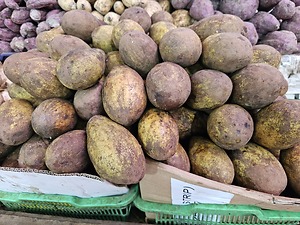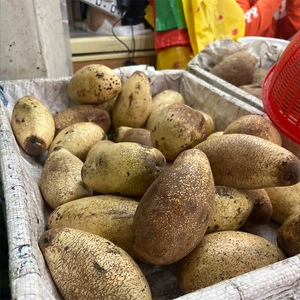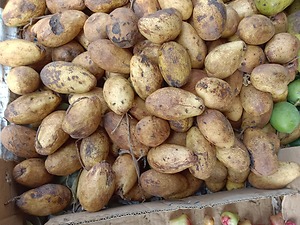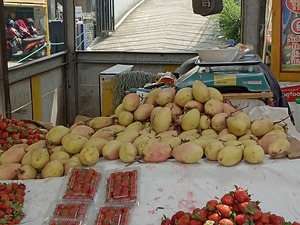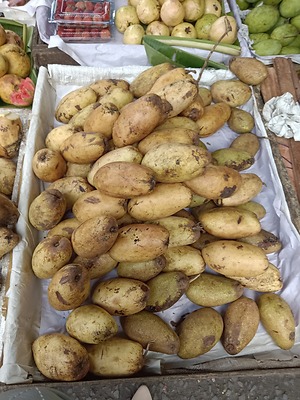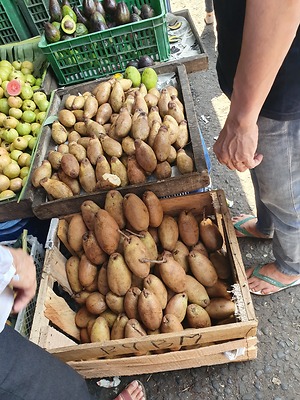


Wild Kemang Mangoes
Estimated Inventory, lb : 0
Description/Taste
Kemang fruits vary in size and shape, depending on the specific type, and generally have an oblong, pyriform, or oval, elongated shape with tapered, blunt ends. The fruits are slightly smaller or similar in size to a mango and have thick, tough skin. The skin is glossy, pale, and semi-smooth when young, transitioning into matte yellow-brown, red-brown, to white-brown hues with a rough, sandy texture once ripe. Mature fruits often feature brown spots and speckling across the surface. These markings are superficial and do not extend into the flesh. Underneath the surface, the white flesh is dense, fibrous, and aqueous with a crunchy and watery consistency. Once ripe, the flesh softens. The flesh also envelops a large brown seed that is edible and grated fresh or cooked in culinary preparations. Kemang fruits release a sharp and robust scent and typically have a sweet, acidic, and sour flavor. The fruit’s taste is said to be somewhat acquired, as some consumers favor its strong, refreshing nature, while others may deem it overpowering.
Seasons/Availability
Kemang is generally available during the rainy season in Southeast Asia, spanning from November to March.
Current Facts
Kemang, botanically classified as Mangifera kemanga, is a tropical species belonging to the Anacardiaceae family. The fruits grow on large deciduous trees ranging from 30 to 45 meters in height and are native to regions of Southeast Asia. Kemang is an ancient indigenous fruit that has recently become endangered of extinction. The fruits were once a prized culinary ingredient, but over time, they have faded from cultivation in favor of other crops, such as modern mango varieties, due to their higher economic value. Kemang is a species within the mango family and is thought to possibly be a wild ancestor of commercial mangoes. There are three main types of Kemang, generally known as Burik, Binglu, and Sabuk. Each type varies slightly in size and appearance. In the present day, Kemang has remained localized to home gardens and wild populations in Southeast Asia and is eaten at multiple stages of maturity as a culinary delicacy. The fruits are favored for their sweet and sour taste and are a seasonal, traditional ingredient.
Nutritional Value
Kemang fruits have not been extensively studied for their nutritional properties. Some sources say the fruits contain vitamin C to strengthen the immune system, potassium to balance fluid levels within the body, vitamin A to maintain healthy organ functions, and folate to help grow tissues. Kemang fruits may also provide vitamin E to guard the cells against the damage caused by free radicals, fiber to regulate the digestive tract, magnesium to control nerves, and other nutrients, including vitamins B6 and B1, phosphorus, carotenoids, and polyphenols.
Applications
Kemang has a sweet and sour flavor suited for fresh and cooked preparations. The fruits can be used when young and firm or when soft and ripe. Young Kemang fruits have a firm, dense, and crunchy consistency. At this stage, the fruits are popularly peeled and shredded or sliced into thin pieces. These pieces can be dipped in sauces or finely chopped into rujak, an Indonesian fruit salad coated in a spicy, tangy, sweet, and savory sauce. Young Kemang fruits are also added into curries for flavor and texture or pickled into a tangy condiment with extended storage properties. Ripe Kemang fruits are typically peeled, and the soft flesh can be eaten out of hand as a snack. The flesh is also popularly blended into juices, smoothies, and shakes. In Indonesia, Kemang fruits are combined with sugar, ice, and coffee powder as a refreshing, sweet beverage. The flesh is also simmered into various syrups for drinks, desserts, and baked goods. In addition to the flesh, the large seed is grated, mixed with fermented soybeans and spices, and eaten as a meal. The grated seed can also be incorporated into various sauces, spreads, and sambals, which are chili pastes. Beyond the fruits, the young leaves of the Kemang tree are harvested and mixed into salads. A well-known dish called lalab or lalapan is prevalently made throughout Southeast Asia, incorporating raw ingredients such as Kemang leaves. These greens are traditionally served with rice. Kemang fruits pair well with aromatics such as garlic, ginger, onion, and chile peppers, spices including nutmeg, tamarind, and cumin, tofu, seafood, and meats such as poultry, beef, and pork. Whole, unopened Kemang fruits should be ripened at room temperature. Once ripe, they should be immediately eaten for the best quality and flavor. They can also be stored for a few days in the refrigerator.
Ethnic/Cultural Info
Kemang trees are often associated with spirits in Indonesia. The large trees are thought to provide homes to spirits, and it is said that spirits frequently linger around the tree’s broad base. There are many superstitions surrounding Kemang trees and spirits, and it is often believed that visitors should not stand or hang out beneath the tree in fear of spiritual encounters. There is also a belief that Kemang fruits can kill people if they fall directly on the head. Kemang fruits are considered heavy due to their large seed, and many Indonesian communities believe the fruits can kill. This is another reason not to stand under the tree. In conjunction with standing under the tree, there is a fear of bad luck by eating the fruit directly under the tree. Local lore states that eating a Kemang fruit beneath the tree will bring misfortune or death.
Geography/History
Kemang trees are native to Southeast Asia and have been growing wild since ancient times. Much of the species’ origins are unknown, as few written records document this tree’s existence. The fruits were historically consumed as a food source and have remained a localized, traditional crop throughout Indonesia and Malaysia into the modern day. Kemang trees thrive in wet, tropical lowlands below 800 meters in elevation and are often found alongside rivers, marshes, or land that seasonally floods. The species is not commercially produced on a large scale but is sometimes grown in small populations in East Kalimantan. Today, Kemang trees are found in Southern and Central Sumatra, Kalimantan, portions of the Malay Peninsula, and West Java, especially near the city of Bogor. When in season, fruits can be collected from the trees and are sold in local markets and select grocers. Kemang trees are rare in the wild and are planted in small quantities in home gardens. Outside Southeast Asia, the species is sometimes cultivated and studied in tropical botanical gardens worldwide.



